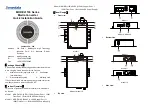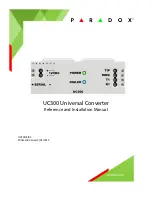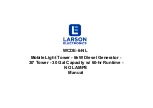
©
2010 Magnum Energy, Inc
.
16
2.0 Installation
Info:
The DC overcurrent device (i.e., fuse or circuit breaker)
must be placed in the positive (RED) DC cable line between
the inverter’s positive DC terminal and the battery’s positive
terminal (RED); as close to the battery as possible.
DC Ground Wire
Route an appropriately sized DC grounding wire (GREEN or bare wire)
from the inverter’s DC Ground Terminal (see Figure 4, Item 17) to a
dedicated system ground. Recommended tightening torque is 45 in. lbs.
DC Negative Wire
Route an appropriately sized DC negative wire (BLACK) from the
negative terminal of the
fi
rst battery string to the inverter’s negative
terminal (see Figure 16 for reference).
Battery Temperature Sensor (Battery charger models only)
Connect the RJ11 connector end of the BTS to the ACCESSORY PORT
(see Figure 3, Item 11) on the inverter. Connect the other end of the BTS
to the negative terminal of the
fi
rst battery string (in same place as the
negative DC wire above); refer to Figure 9 for the correct hardware
placement.
DC Positive Wire
Mount the DC fuse block and disconnect (or circuit breaker assembly)
as near as practical to the batteries, and then remove the fuse (or
open the circuit breaker).
WARNING
: DO NOT close the DC fuse/DC disconnect (or
close the DC circuit breaker) to enable battery power to
the inverter at this time. This will occur in the
Functional
Test
after the installation is complete.
Route and connect an appropriately sized DC positive wire (RED) from
the DC fuse block (or circuit breaker assembly) to the inverter’s positive
DC terminal.
Connect a short wire (same rating as the DC wires) to one end of the
fuse block and the other end of the short wire to the positive terminal of
the last battery string (see Figure 16). This is essential to ensure even
charging and discharging across the entire battery bank.
Ensure the DC wire connections (on the batteries, inverter, and fuse
lugs/DC circuit breaker) are
fl
ush on the surface of the DC terminals
and the hardware (lock washer and nut) used to hold these connections
are stacked correctly (see Figures 9 and 10).
Verify all DC connections are torqued from 10 to 12 foot-pounds.
Once the DC connections are completely wired and tested, coat the
terminals with an approved anti-oxidizing spray.
Press on the red and black terminal covers to the inverter’s DC connec-
tors to secure them in place.
If batteries are in an enclosure, perform a
fi
nal check of the hold down
brackets and all connections. Close and secure the battery enclosure.
















































